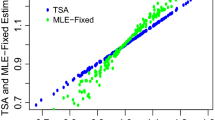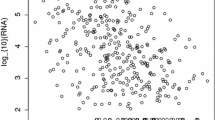Abstract
Cell counts in contingency tables can be smoothed using loglinear models. Recently, sampling-based methods such as Markov chain Monte Carlo (MCMC) have been introduced, making it possible to sample from posterior distributions. The novelty of the approach presented here is that all conditional distributions can be specified directly, so that straight-forward Gibbs sampling is possible. Thus, the model is constructed in a way that makes burn-in and checking convergence a relatively minor issue. The emphasis of this paper is on smoothing cell counts in contingency tables, and not so much on estimation of regression parameters. Therefore, the prior distribution consists of two stages. We rely on a normal nonconjugate prior at the first stage, and a vague prior for hyperparameters at the second stage. The smoothed counts tend to compromise between the observed data and a log-linear model. The methods are demonstrated with a sparse data table taken from a multi-center clinical trial.
Similar content being viewed by others
References
Agresti, A. (1990).Categorical Data Analysis. Wiley.
Agresti, A. (1996).An Introduction to Categorical Data Analysis. Wiley.
Albert, J. and S. Chib (1997). Bayesian tests and model diagnostics in conditionally independent hierarchical models.J. Amer. Statist. Assoc. 92 916–925.
Bishop, Y.M.M., S.E. Fienberg, and P.W. Holland (1975).Discrete Multivariate Analysis. Cambridge, MA: MIT Press.
Dellaportas, P. and A.F.M. Smith (1993). Bayesian inference for generalized linear and proportional hazards models via Gibbs sampling.Appl. Statist. 42 443–459.
Dempster, A.P., N.M. Laird, and D.B. Rubin (1977). Maximum likelihood from incomplete data via the EM algorithm (with discussion).J.R. Statist. Soc. B39 1–38.
Gilks, W.R. and P. Wild (1992). Adaptive rejection sampling for Gibbs sampling.Appl. Statist. 41 337–348.
Laird, N.M. (1978). Empirical Bayes methods for two-way contingency tables.Biometrika 65 581–590
Lawless, J.F. (1982).Statistical Models and Methods for Lifetime Data. Wiley.
Leonard, T. and M.R. Novick (1986). Bayesian full rank marginalization for two-way contingency tables.Journal of Educational Statistics 11 33–56.
Spiegelhalter, D.J., A. Thomas, N.G. Best, and W.R. Gilks (1997).BUGS: Bayesian inference Using Gibbs Sampling, Version 0.6 Cambridge: Medical Research Council Biostatistics Unit.
Author information
Authors and Affiliations
Additional information
The research for the first author was supported by Brain Pool program of the Korean Federation of Science and Technology Societies. The research for the second author was partially supported by KOSEF through Statistical Research Center for Complex Systems at Seoul National University.
Rights and permissions
About this article
Cite this article
Green, P.E., Park, T. Bayesian methods for contingency tables using Gibbs sampling. Statistical Papers 45, 33–50 (2004). https://doi.org/10.1007/BF02778268
Received:
Revised:
Issue Date:
DOI: https://doi.org/10.1007/BF02778268




